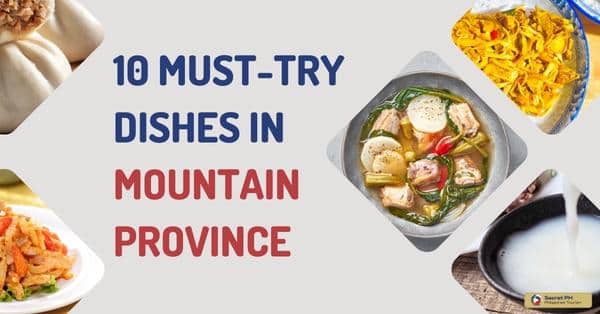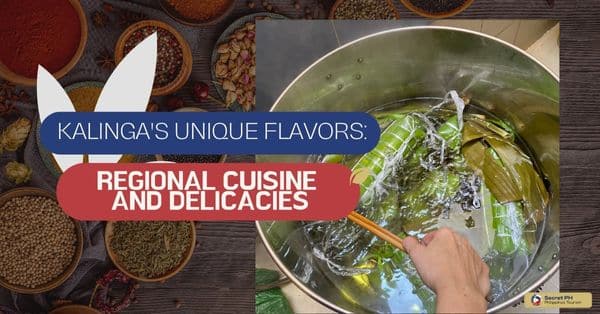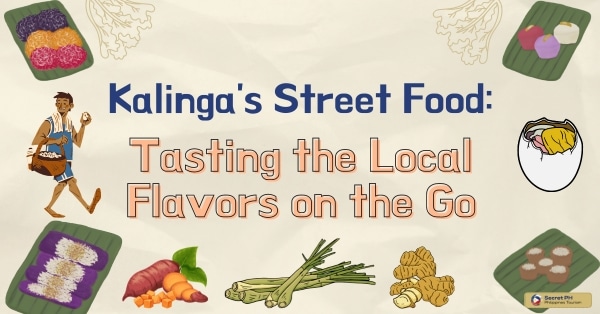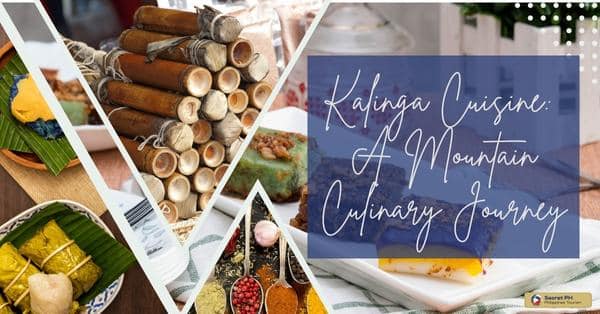Discover the allure of Ifugao cuisine, an exquisite blend of indigenous flavors and traditions from the Philippines’ Cordillera region. From the distinctive Pinikpikan chicken dish to modern culinary interpretations, the province’s culinary heritage unfolds. Immerse yourself in markets, engage with locals, and relish the unique connection between land and plate.
This article will give you a taste of what makes Ifugao fare so special and where to find it. You’ll learn about the main ingredients used in Ifugao cuisine, the traditional dishes you can expect to find, as well as some modern variations. Finally, we’ll provide tips on where to try this amazing culinary experience and what to expect when you do.
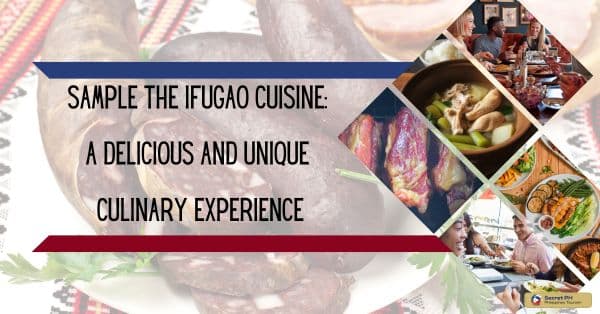
Discover the Deliciousness of Ifugao Cuisine
Ifugao cuisine is a unique culinary experience that offers something for everyone. With its distinct flavors and fragrant aromas, it’s sure to tantalize your taste buds. From savory dishes like pinikpikan (a spicy chicken stew) to sweet desserts such as binallay (a type of sweet yam cake), there’s something for everyone to enjoy.
Ifugao cuisine also boasts of its rich cultural heritage. The Ifugaos are a unique and proud ethnic group who have lived in the northern Filipino highlands for centuries. Their cuisine is deeply rooted in their traditions, customs, and culture. Over the years, they’ve developed recipes that blend indigenous ingredients with modern cooking techniques, creating dishes that are flavorful yet surprisingly simple.
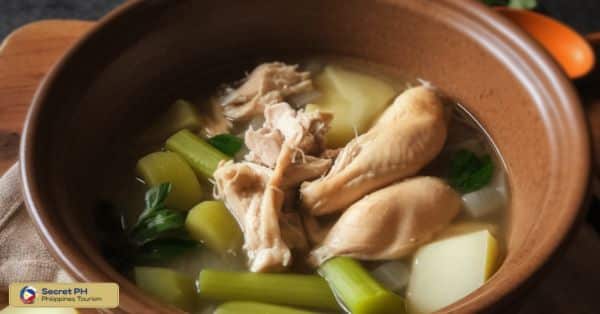
The Ingredients of Ifugao Cuisine
Ifugao Cuisine is characterized by its unique flavors, fresh ingredients, and traditional cooking techniques that have been passed down through generations. With its rich agricultural landscape, Ifugao boasts a variety of ingredients that form the foundation of its cuisine. Let’s explore some of the key ingredients that make Ifugao Cuisine truly special.
Rice – The Staple Crop: Rice forms the backbone of Ifugao Cuisine. The terraced rice paddies for which Ifugao is famous provide an abundant supply of high-quality rice. The Ifugao people take great pride in cultivating and harvesting this staple crop, which is used in a multitude of dishes.
Native Vegetables – A Bounty of Flavors: Ifugao’s fertile soil yields a plethora of native vegetables that are integral to its cuisine. From “tinawon” (heirloom rice) to “patani” (lima beans), “kamote” (sweet potato) to “kayapa” (bamboo shoots), and “pako” (edible fern), these vegetables add a unique taste and texture to various soups, stir-fries, and side dishes.
Indigenous Herbs and Spices – Infusing Flavor: Ifugao Cuisine incorporates a wide array of indigenous herbs and spices to enhance the flavor profiles of its dishes. Ingredients like “utong” (ginger), “alagao” leaves, “kayumanggi” leaves, “dagdagay” (wild ginger), “luy-a” (turmeric), and “patani” (chili) are commonly used to infuse dishes with vibrant flavors.
Freshwater Fish and Meat – Sustaining Protein: Being a landlocked province, Ifugao relies heavily on freshwater fish from its rivers and streams. “Dalag” (mudfish) and “ayan” (freshwater eel) are popular choices, appreciated for their delicate texture and mild taste. In addition to fish, Ifugao cuisine also incorporates locally sourced meats such as “kan-ew” (native chicken) and “bontoc” (pork).
Indigenous Rice Wine – Cheers to Tradition: No exploration of Ifugao Cuisine is complete without mentioning the traditional rice wine called “tapuy.” Made from fermented glutinous rice, tapuy holds a special place in Ifugao culture. It is often served on special occasions and celebrations, symbolizing unity and camaraderie.
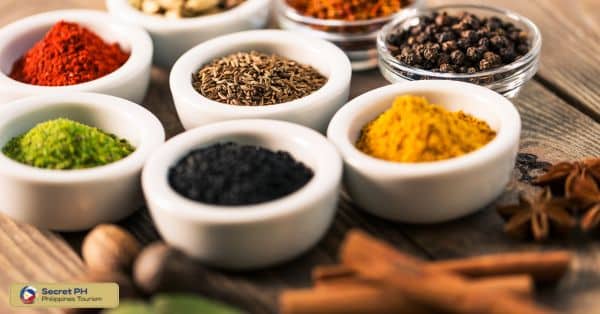
Traditional Ifugao Dishes
Ifugao cuisine reflects the region’s rich agricultural landscape and the cultural heritage of the Ifugao people. From hearty stews to unique rice dishes, traditional Ifugao dishes offer a delightful culinary experience. Let’s delve into some of these delectable dishes!
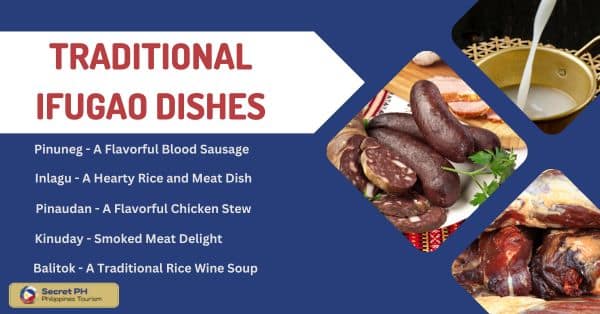
Pinuneg – A Flavorful Blood Sausage
Pinuneg is a traditional Ifugao dish that showcases the resourcefulness and creativity of the local cuisine. It is a type of blood sausage made from the blood of native pigs, mixed with ground rice, ginger, and various aromatic herbs and spices. The mixture is stuffed into pig intestines and then boiled or grilled to perfection. Pinuneg’s rich flavor and unique texture make it a popular choice among locals and visitors alike.
Inlagu – A Hearty Rice and Meat Dish
Inlagu is a savory dish that combines rice and meat, offering a comforting and satisfying meal. It is made by cooking glutinous rice together with tender chunks of pork or chicken, flavored with indigenous herbs and spices. The dish is typically wrapped in banana leaves and steamed, allowing the flavors to meld together. Inlagu is often enjoyed during special occasions, festivals, and gatherings, bringing people together through its delightful taste.
Pinaudan – A Flavorful Chicken Stew
Pinaudan is a delicious chicken stew that is a staple in Ifugao cuisine. This hearty dish features tender chicken pieces simmered in a flavorful broth, enriched with native vegetables such as bamboo shoots, sweet potatoes, and leafy greens. Indigenous herbs and spices are added to enhance the aroma and taste of the stew. Pinaudan is best enjoyed with a serving of warm rice, offering a hearty and comforting meal.
Kinuday – Smoked Meat Delight
Kinuday is a unique Ifugao delicacy that showcases the traditional smoking technique used in the region. It involves smoking meat, usually pork or carabao (water buffalo), over a low fire for several hours. The result is a smoky, flavorful meat that can be enjoyed on its own or used as an ingredient in various dishes. Kinuday is often served with native rice and vegetables, providing a burst of smoky goodness in every bite.
Balitok – A Traditional Rice Wine Soup
Balitok is a traditional Ifugao soup that features the region’s beloved rice wine called “tapuy.” This unique dish combines tapuy with a variety of ingredients, including chicken, ginger, onions, and native vegetables. The soup is simmered slowly, allowing the flavors to meld together while the tapuy adds a distinct tangy note. Balitok is often served during festive occasions and gatherings, celebrating the rich culinary heritage of the Ifugao people.
Ifugao cuisine is a testament to the creativity, resourcefulness, and rich cultural heritage of the Ifugao people. These traditional dishes not only offer a delightful culinary experience but also provide a window into the traditions and way of life in this vibrant region of the Philippines.

Modern Ifugao Cuisine
Ifugao cuisine, while deeply rooted in tradition, has also evolved to incorporate modern influences and culinary techniques. Today, the local chefs and food enthusiasts in the Ifugao province of the Philippines are pushing the boundaries of flavor and presentation, creating a fusion of traditional Ifugao dishes with contemporary twists. Let’s explore the exciting world of modern Ifugao cuisine!
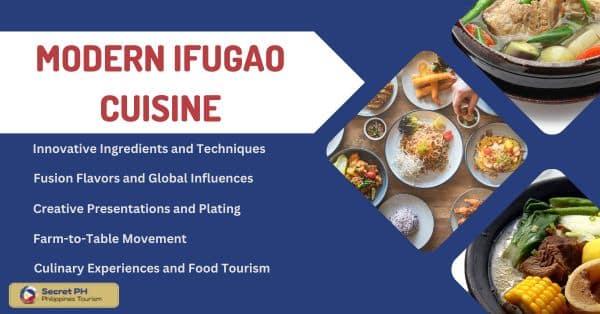
Innovative Ingredients and Techniques
Modern Ifugao cuisine embraces innovation by incorporating new ingredients and cooking techniques while staying true to the region’s culinary heritage. Local chefs experiment with diverse flavors from different cuisines and introduce them into traditional Ifugao dishes. They utilize modern equipment and cooking methods to elevate the dining experience, offering a harmonious blend of old and new.
Fusion Flavors and Global Influences
In the spirit of culinary exploration, modern Ifugao cuisine embraces fusion flavors and global influences. The aim is to create exciting and unique dishes that reflect the diversity of tastes in contemporary cuisine. Chefs in Ifugao combine traditional ingredients with international flavors, such as incorporating soy sauce or chili peppers into classic recipes, resulting in dishes that are familiar yet distinctively Ifugao.
Creative Presentations and Plating
Visual appeal plays an essential role in modern Ifugao cuisine. Chefs pay careful attention to the presentation and plating of their dishes, creating stunning works of art on the plate. They use local ceramics, bamboo, and other natural materials to enhance the visual aesthetics of the dining experience. The combination of vibrant colors, intricate garnishes, and artistic arrangements make dining a feast for both the taste buds and the eyes.
Farm-to-Table Movement
With a focus on sustainability and supporting local farmers, the farm-to-table movement has gained traction in modern Ifugao cuisine. Chefs prioritize sourcing fresh ingredients directly from local farmers and artisans, ensuring the highest quality produce while minimizing environmental impact. This movement not only highlights the rich agricultural landscape of the region but also promotes a closer connection between food producers and consumers.
Culinary Experiences and Food Tourism
The rise of modern Ifugao cuisine has also led to an increase in culinary experiences and food tourism in the region. Visitors can now participate in cooking classes, food tours, and immersive dining experiences that showcase the unique flavors and techniques of Ifugao cuisine. This trend has not only boosted the local economy but also fostered a sense of pride in the culinary traditions of Ifugao.
Modern Ifugao cuisine represents the dynamic evolution of traditional dishes, reflecting the creativity, adaptability, and global influences that shape contemporary gastronomy. By embracing innovation while honoring their cultural roots, chefs in Ifugao have created a culinary landscape that is both exciting and deeply rooted in tradition.
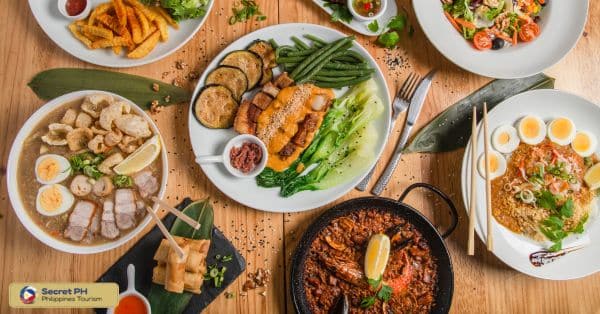
Where to Try Ifugao Cuisine
Ifugao cuisine offers a tantalizing journey through the flavors and history of the Cordillera region in the Philippines. To truly immerse yourself in the authentic tastes and cultural significance of this culinary tradition, here are some noteworthy places where you can experience the essence of Ifugao cuisine:
1. Hagabi Restaurant
Address: W366+GV8, Banaue, Ifugao
Opening Hours: 8 AM–9 PM
For directions, click here.
2. Dindo’s Restaurant
Address: P54H+C65, Lamut, Ifugao
Opening Hours: 24 hours
Phone: +63935 192 5958
For pictures, booking, and more information, click here.
For directions, click here.
3. The Riverview Restaurant
Address: Q4RG+3PW Jhun-Berline Marie, Basilio Street, Lagawe, Ifugao
Opening Hours: 9:30 AM–9 PM
For directions, click here.
4. Uyami’s Green View Lodge and Restaurant
Address: Poblacion, Banaue, Ifugao, Philippines 3601, Banaue, 3601 Ifugao
Opening Hours: 6:30 AM–9 PM
Phone: +63920 540 4225
For pictures, booking, and more information, click here.
For directions, click here.
5. The Gazebo
Address: R429+GV2, Lagawe, Ifugao
Opening Hours: 9 AM–7 AM
Phone: +63936 945 7013
For directions, click here.

Tips for Sampling Ifugao Cuisine
If you find yourself in the beautiful region of Ifugao in the Philippines, exploring the unique culinary landscape is a must. With its blend of traditional flavors and modern influences, sampling Ifugao cuisine offers a delightful adventure for your taste buds. To make the most of this culinary journey, here are some helpful tips to enhance your experience.
1. Embrace Local Specialties– When sampling Ifugao cuisine, be sure to try the region’s local specialties. From pinikpikan (native chicken soup) to etag (smoked pork), each dish carries a distinct flavor profile that represents the rich culinary heritage of Ifugao. Don’t hesitate to ask locals or your server for recommendations on must-try dishes.
2. Explore Street Food Delights– Immerse yourself in the bustling street food scene of Ifugao. Wander through local markets and roadside stalls, where you’ll find an array of delectable snacks and treats. Indulge in crispy fried snacks like binatog (corn kernels with grated coconut) or tupig (grilled sticky rice cake). These street food delights offer a quick taste of Ifugao’s vibrant flavors.
3. Attend Local Food Festivals– Ifugao is known for its lively food festivals, where you can experience the best of the region’s culinary traditions in one place. Keep an eye out for events like the Imbayah Festival or the Tapew Festival, which celebrate indigenous food and culture.
4. Dine with Locals– To truly immerse yourself in the Ifugao culinary experience, seek out opportunities to dine with locals. Whether it’s joining a community meal or being invited into a home for a traditional feast, dining with locals offers an authentic taste of Ifugao hospitality and allows you to savor traditional dishes prepared with love and care.
5. Respect Local Customs and Traditions– While indulging in Ifugao cuisine, it’s essential to respect local customs and traditions. Familiarize yourself with proper dining etiquette, such as eating with your hands when appropriate or observing traditional rituals before a meal.

In conclusion
Ifugao cuisine is an extraordinary journey through the flavors and culture of a vibrant region in the Philippines. From traditional delicacies to modern fusion dishes, this culinary tradition offers something for everyone.
Whether you’re exploring street food stalls or attending local food festivals, there are plenty of opportunities to sample the unique tastes of Ifugao cuisine. So take a trip through this vibrant culinary heritage and let your taste buds be delighted by the delicious flavors of Ifugao cuisine.



